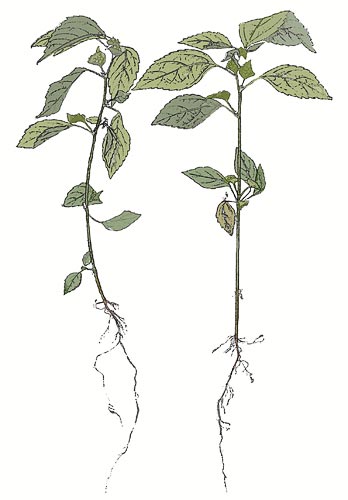Weeds
Acalypha australis L. - Southern Acalypha
Taxonomic position.
Family Euphorbiaceae, genus Acalypha L.Synonyms.
A. pauciflora Hornem., A. genuina Spreng. Syst., A. virgata (Thunb. nec L.),Biological group.
Annual weed plant.Morphology and biology.
Stalk is straight, ridged, strongly branched; covered with rigid decumbent light hairs. Plant is 6-50 cm tall. Phyllotaxy is alternate; leaves are from almost sedentary to long petiolar, 1-9 cm long, 1 to 4 cm wide, thin, from lanceolate to oval in shape, pointed at tip, strongly serrate along margin, cuneate at base. Three basic ribs run from the base; the leaves are hairy or glabrous on ribs. Flowers are aggregated in axillary or apical inflorescences in the form of ears. The lower part of inflorescence contains staminal flowers; the upper part bears pistillate flowers. Spikelets of staminal flowers are lengthened, reddish, thin, 1-3 cm long. Staminal flowers are located in axillae of lanceolate small bracts, having four small thin coriaceous sepals. Corolla is absent. Staminal threads are free, having two free overhanging pollen bags. Pistillate spikelets are ball-shaped, consisting of 3-5 flowers, located in axillae of bracts. Bracts are large, 1-2 cm long, hood-like. Sepals are ovoid, pointed and ciliate. Ovary is densely pubescent, with long hairs, 3-4-locular. Column is up to 3 mm long, at base crosswise dissected, with 6-8 thin lobes. Fruit is rigidly pubescent. Seeds are 1.5-2 mm long, 1.2-1.5 mm wide, ovoid, smooth, with a fine narrow appendage, sulfur to light brown. Weight of 1000 seeds is 2 g. The plant blossoms in July-August, fructifies in August-September. Fruits ripen at various times. They mainly drop in field and litter ground. Some fruits get into grain (especially in late crops).Distribution.
Origin described as South America. General distribution includes Korea, China (including Manchuria), Japan and the Americas. In the territory of the former USSR the species is distributed in the Far East (Ussuri, Dauriya, Nizhnyaya-Zeya, Bureya, Southern-Kuril districts) and the Caucasus (adventive).Ecology.
Plant grows on light (sandy), medium (loamy), and heavy (clay) soils. It can grow in acidic, neutral, and alkaline soils. It prefers weak shading (light forests) or places that are open. The plant requires humid soils. Therefore, in anthropogenic habitats it is found in waste places and cultivated fields in lowlands. In nature the plant grows along river banks, on sandy or clay ground, in light forests and glades.Economic significance.
Weed is present in the Far East. In newly plowed fields weed abundance is low in the first years. In following years, the weed is found frequently among crops of all cultures (except rice). The plant often litters kitchen gardens, is found along country roads and on one- or two-year fallow lands. This weed is highly harmful to crops despite its small size (Buch et al., 1981). Control measures are the same as for any annual weed. Good results in weed control are reached with a combination of agronomic and chemical measures. Seed cleaning of late harvest crops to remove weed seed is recommended.Reference citations:
Buch T.G., Kachura N.N., Shvydkaya V.D., Andreeva E.R. 1981. Weeds of the Primorskii Territory and their control. Vladivostok: Dalnevostochnoe knizhnoe izdatelstvo. 256 pp. (in Russian).Kharkevich S.S., ed. 1991. Vascular plants of the Soviet Far East. V. 5. Saint Petersburg: Nauka. 392 pp. (in Russian).
Shishkin, B.K. & E.G. Bobrov, eds. 1949. Flora of the USSR. V. 14. Leningrad-Moscow: AN SSSR. 790 pp. (in Russian).
Shishkin I.K. 1936. Weed plants of southern part of the Far East. Khabarovsk. 144 pp. (in Russian).


